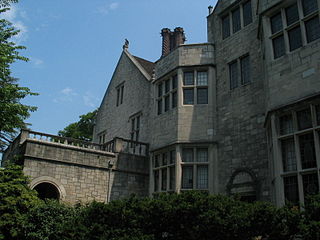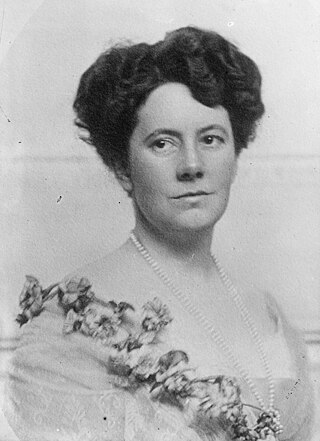
Chamaecyparis obtusa is a species of cypress native to central Japan in East Asia, and widely cultivated in the temperate northern hemisphere for its high-quality timber and ornamental qualities, with many cultivars commercially available.

Chamaecyparis pisifera is a species of false cypress, native to central and southern Japan, on the islands of Honshū and Kyūshū.

The United States National Arboretum is an arboretum in northeast Washington, D.C., operated by the United States Department of Agriculture's Agricultural Research Service. It was established in 1927 by an act of Congress after a campaign by USDA Chief Botanist Frederick Vernon Coville.

The Arnold Arboretum of Harvard University is a botanical research institution and free public park, located in the Jamaica Plain and Roslindale neighborhoods of Boston, Massachusetts. Established in 1872, it is the oldest public arboretum in North America. The landscape was designed by Charles Sprague Sargent and Frederick Law Olmsted and is the second largest "link" in the Emerald Necklace. The Arnold Arboretum's collection of temperate trees, shrubs, and vines has an emphasis on the plants of the eastern United States and eastern Asia, where arboretum staff and colleagues are sourcing new material on plant collecting expeditions. The arboretum supports research in its landscape and in its Weld Hill Research Building.

The Bartlett Arboretum and Gardens in Stamford, Connecticut, contains 93 acres of parkland, gardens, landscapes, and hiking trails that focus on the regional plants, ecology and character of Southwestern New England. The Arboretum is open and accessible to the public every day of the year and is located at 151 Brookdale Road.

The Sister Mary Grace Burns Arboretum, on the campus of Georgian Court University, in Lakewood Township, New Jersey, United States, was once the landscaped park for the winter home of George Jay Gould, millionaire son of railroad tycoon Jay Gould.
Lendonwood Gardens are non-profit botanical gardens in Grove, Oklahoma.

Planting Fields Arboretum State Historic Park, which includes the Coe Hall Historic House Museum, is an arboretum and state park covering over 400 acres (160 ha) located in the village of Upper Brookville in the town of Oyster Bay, New York.

The JC Raulston Arboretum is a 10-acre (40,000 m2) arboretum and botanical garden administered by North Carolina State University, and located in Raleigh, North Carolina. It is open daily to the public without charge.

The Haverford College Arboretum is an arboretum comprising the entire campus of Haverford College, in Haverford, Pennsylvania. It is open daily, dawn to dusk, without charge.

The North Carolina Arboretum is an arboretum and botanical garden located within the Bent Creek Experimental Forest of the Pisgah National Forest at 100 Frederick Law Olmsted Way, southwest of Asheville, North Carolina near the Blue Ridge Parkway. It is open daily except for Christmas Day. There is no admission charge, but some parking fees do apply.

Larz Anderson was an American diplomat and bon vivant. He served as second secretary at the United States Legation to the Court of St James's, London; as first secretary and later chargé d'affaires at the United States Embassy in Rome; as United States Minister to Belgium; and then briefly as the Ambassador to Japan. He also unsuccessfully sought appointment as Ambassador to Italy.

Larz Anderson Auto Museum is located in the Anderson Carriage House on the grounds of Larz Anderson Park in Brookline, Massachusetts and is the oldest collection of motorcars in the United States.

Isabel Anderson, née Isabel Weld Perkins, was a Boston heiress, author, and society hostess who left a legacy to the public that includes a park and two museums.

William Fletcher Weld was an American shipping magnate during the Golden Age of Sail and a member of the prominent Weld family. He later invested in railroads and real estate. Weld multiplied his family's fortune into a huge legacy for his descendants and the public.

Larz Anderson Park is a wooded, landscaped, and waterscaped 64-acre (26 ha) parkland in Brookline, Massachusetts that is listed on the National Register of Historic Places. The southwest corner of the park is in Boston. The park contains playing fields, picnic areas, gardens, waterways, an ice skating rink, and two sites of special interest:
The Seed Herbarium Image Project (SHIP), is an initiative of the Arnold Arboretum of Harvard University to create a web-based repository of high-resolution digital images documenting the morphology of woody plant seeds and selected fruit structures. Headquartered at the Arboretum’s Dana Greenhouse facility and coordinated and photographed by curatorial assistant Julie McIntosh Shapiro, the Seed Herbarium Image Project supports the work of educators and professionals in horticulture and the botanical sciences, particularly in conservation research and management of rare and endangered species. The digitized images of seeds offer an important new aid for teaching seed identification—a fundamental skill in plant propagation, hybridization, and distribution—and serve as a resource for nurserymen, horticulturists, botanical curators, taxonomists, ecologists, and the general public. SHIP also provides an online resource for botanical institutions and nurseries to verify their collections and inventories. SHIP is made possible through the generous support of the Stanley Smith Horticultural Trust, Cabot Family Charitable Trust, and the J. Frank Schmidt Family Charitable Foundation.

Acer palmatum, commonly known as Japanese maple, palmate maple, or smooth Japanese maple (Korean: danpungnamu, 단풍나무, Japanese: irohamomiji, イロハモミジ, or momiji,, is a species of woody plant native to Korea, Japan, China, eastern Mongolia, and southeast Russia. Many different cultivars of this maple have been selected and they are grown worldwide for their large variety of attractive forms, leaf shapes, and spectacular colors.
Peter Del Tredici is an American botanist and author. He is a former senior research scientist at Arnold Arboretum for 35 years and a lecturer at the Harvard Graduate School of Design. He was appointed curator of the Larz Anderson Bonsai Collection in 1982 and was editor of the journal Arnoldia from 1989 to 1992.

Bonsai is a Japanese art form using trees grown in containers. Similar practices exist in other cultures, including the Chinese tradition of penjing from which the art originated, and the miniature living landscapes of Vietnamese hòn non bộ. The term "bonsai" itself is a Japanese pronunciation of the earlier Chinese term penzai. The word bonsai is often used in English as an umbrella term for all miniature trees in containers or pots. This article focuses on the history of bonsai in Japan and, in modern times, worldwide.

















